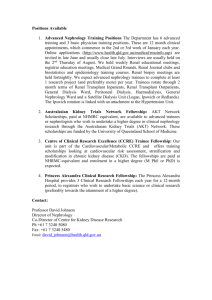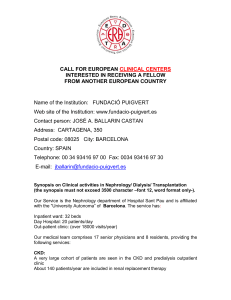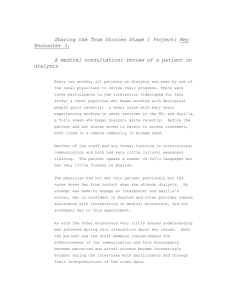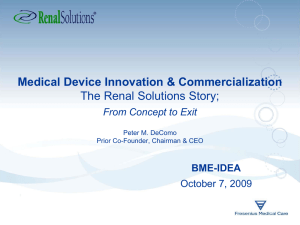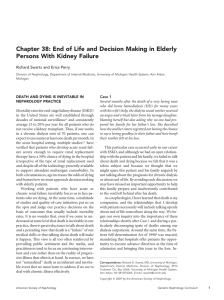Renal Replacement Therapy Considerations for the Internal Medicine Resident
advertisement
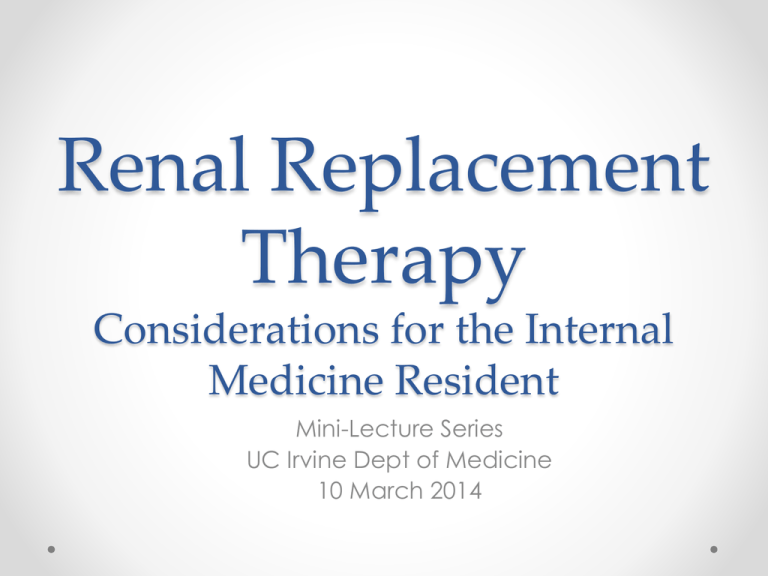
Renal Replacement Therapy Considerations for the Internal Medicine Resident Mini-Lecture Series UC Irvine Dept of Medicine 10 March 2014 Goals/Objectives • To assist medical decision-making in acute renal failure • To understand the role of renal replacement therapy in the inpatient setting. • To make cognizant possible complications from dialysis and potential challenges in the management of patients undergoing dialysis Case 56yo F presents to the emergency room with weakness and altered mental status. She has known chronic kidney disease stage V believed to be due to hypertension and uncontrolled diabetes and was evaluated by nephrology one month prior as an outpatient with discussions at that time to prepare for renal replacement therapy. One month ago Today Na 137 WBC 11.6 Na 129 WBC 17.8 T. Protein 5.4 PT 11.5 K 4.8 Hb 9.0 K 5.9 Hb 5.9 Alb 2.4 aPTT 38.9 Cl 105 Hct 26.3 Cl 101 Hct 18.2 Alk Phos 106 INR 1.08 CO2 21 Plt 251 CO2 15 Plt 192 T. Bili 0.5 BUN 48 BUN 90 AST 16 Cr 3.1 Cr 5.5 ALT 11 Glucose 97 Glucose 49 Ca 7.8 Ca 6.0 Mg 1.9 Mg 1.8 Phos 8.0 Phos 8.5 ABG on 2L NC: 7.22/40.1/145/15 Case • Physical exam shows normal vital signs. She is an obese female who was lethargic but alert and oriented x4. Physical examination was otherwise unremarkable including rectal examination, which was negative for masses or bleeding. • Hypoglycemia is addressed by witholding all insulin and providing dextrose source. • Given: o o o o o Acute drop in hemoglobin Acute kidney injury Acidemia Altered mental status Hyperkalemia Do you call nephrology? Indications • “A-E-I-O-U” o o o o o Acidosis Electrolyte Disturbance Intoxication Overload Uremia • Consult nephrology with any of these life threatening conditions. Modalities • • • • Intermittent hemodialysis (IHD) Continuous renal replacement therapy (CRRT) Sustained low-efficiency dialysis (SLED) Peritoneal dialysis (PD) Complications and Challenges • • • • • • Dialysis catheter-related problems Hypotension Arrhythmias Dialyzer reactions Problems with CRRT Drug Dosing Adjustments Intradialytic Hypotension • More often seen with IHD, although can be a result of all modalities • Etiology – intravascular depletion o Rapid clearance of uremic solutes decrease serum osmolality—thereby, driving fluid intracellularly o Don’t forget to rule out any other underlying etiologies, like sepsis! Air embolus! • Initial management options o o o o Fluid bolus 250 ml +/- 25% albumin Turning off dialysis Decreasing dialysate temperature to promote vasoconstriction Communicate with Nephrology Arrythmia • Etiology o Rapid shift in electrolytes o Ultrafiltration of antiarrhythmic drugs • Digoxin/digitalis • If arrhythmia is resulting in hemodynamic compromise, stop dialysis immediately and cardiovert Dialyzer Reactions • Type A – anaphylactic Rare: 4 of every 100,000 sessions Presents in the first few minutes Symptoms varies: urticaria, flushing, chest pain, back pain, vomiting, chills Etiology: due to residual amounts of ETHYLENE OXIDE (used to sterilize dialyzers) o Management: discontinue dialysis; treat anaphylaxis o o o o • Type B More common; less severe: 4 of every 100 session Presents after the first 15 minutes Symptoms: chest pain, back pain, dyspnea, GI symptoms Etiology: due to unsubstituted cellulose dialyzer membranes and activation of complement. o Management: if symptoms resolve, continue dialysis with supportive care. o o o o Dialysis Catheter-Related Problems • Bacteremia! • Thrombus or fibrin sheath formation within or around catheter o Consider Heparin or Alteplase • Do not use subclavian vein catheters o There is a high risk of stenosis, preventing the option of a future AV fistula or graft in that extremity. Problems with CRRT • Electrolytes – Check at least TWICE daily o Hypophosphatemia o Hypokalemia o Hypomagnesemia • Anticoagulation o Heparin o Argatroban o Citrate • Hypothermia o Warm the replacement fluid or blood Drug Dosing • In general, removal of drugs on IHD, CRRT, or PD has not been tested • It is based theoretically on molecular weight and chemical composition. • Consult with the pharmacist and with nephrology Return to the CASE • No evidence of bleeding. • Nephrology was made aware of the patient but no decision for dialysis was made. • If there were evidence of bleeding, urgent dialysis may have been appropriate. • In this patient’s case, with worsening renal function, she likely experienced sulfonylurea toxicity contributing to hypoglycemia • Anemia likely 2/2 chronic kidney disease • Acidemia was medically managed with sodium bicarbonate supplementation. References • Kollef, et al. Washington Manual of Critical Care 2nd Edition. 2012 • UpToDate: Renal Replacement Therapy in Acute Kidney Injry in Adults: Indications, Timing, and dialysis dose. • Wilson, Samuel Eric. Vascular Access: Principles and Practice 5th Edition. 2012. 120-125. • Holubek, et al. Use of Hemodialysis and Hemoperfusion in Poisoned Patients 2008 Kidney International
